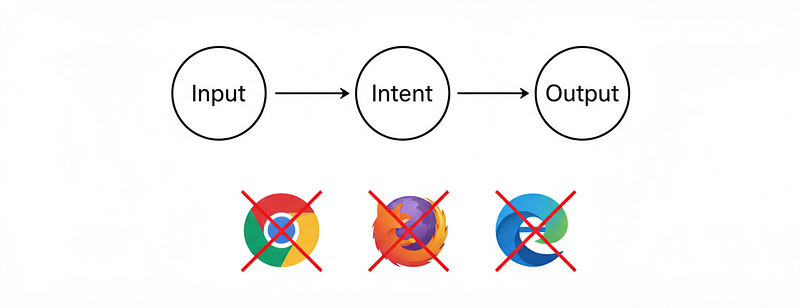Don Norman, Forgive Us! Machine-Centered Design is Here.

Now something strange is happening. For the first time, we’re not the only “users” on the web. AI has joined the party and it doesn’t care about our buttons, scroll bars, or fancy icons.
So maybe it’s time to ask: what if AI is not a tool, but a persona?
Don Norman, please forgive me, but what if human-centered design is coming to its EOL? Is AI becoming the main user? [1]
The birth of a new “user”
When we talk to ChatGPT, Gemini, or any of the AI browsers like Comet or Atlas, we’re not just using software, we’re interacting with something that reads, interprets, and acts in its own strange way.
Humans read for meaning, skim headlines, get distracted by memes. AIs extract meaning. They digest everything. They don’t wander down a YouTube rabbit hole or check the fridge mid-thought…then come back and forget what they were doing.
If an AI becomes a real “user” of the web, the design logic flips. Are We Ready for Machine-Centered Design?
When the internet stops being for humans
“Delight is the emotional fuel of habit.” — Nesrine Changuel
Every detail of a webpage today exists for human eyes: layouts, typography, emotion, color. All that design effort is meant to guide our attention and feelings. It’s been like this for the last 30 years. But in ten years, we might not be the ones “seeing” it.
You’ll say: “Hey AI, book me a flight to NY and send the receipt to finance.” And your AI assistant will do it, without you ever opening a site. No login screens, no cookie pop-ups, no “Continue with Google.” Just intent, action, done.
If AIs become the primary users, our web the way it is today will lose its importance. From a colorful, animated, interactive experience that provides information, value, brand awareness, marketing relevance or just pure delight to humans, it may turn into a semantic web, built for reading by machines first and humans second. [2]
The emotional payoff (joy, pride, curiosity, relief) will be delegated to the UX of the AI layer.
The AI persona: superpowers and blind spots
This new persona arrives with gifts and gaps. It can sweep billions of pages before you finish your espresso. Boredom is not in its vocabulary.
How does AI read a web page? Brand palettes, hover micro-interactions, hero-section videos, none register. Yet it has no nose for sincerity, no gut check for trust. Confidence reads like truth; spin masquerades as fact. That’s why we’ll need to teach it context and ethics, the way we teach kids not to take candy from strangers. And we may need to radically change the vision, the metaphor and the philosophy around User Experience. [3]
Update your UX philosophy: from human-centered to machine-centered design
AI browsers? Actually, I’m starting to envision a future with no “browsing” at all. Browsing is a human ritual. Curiosity mixed with distraction, those ten minute detours on Reddit, Instagram, or a sudden interest in a YouTube tutorial.
For years, design has been “human-centered.” We build everything around human behavior, perception, and emotion. But with AI becoming both audience and actor, we’ll need to invent a parallel discipline: we’ll call it machine-centered design.
That means designing content so that AIs can:
- Read it easily
- Verify it quickly
- And translate it into something humans actually care about.
Our job may no longer be just to communicate with people, but to communicate through machines, to design content in a way that is meaningful and optimized for AI.
Maybe websites will come with 3 versions: desktop, mobile, and AI.
Maybe metadata will become the new foundation layer for AIX (Artificial Intelligence Experience).
Designers, then, will have to speak two languages: the emotional one for humans, and the structured one for AIs.

Rethinking logins, sign-ups, and payments
If you’ve tried buying something through one of the new AI browsers, you’ve probably felt it: that moment where the magic just… breaks.
You tell the assistant, “Book me a flight,” or “Order those headphones,” and then it awkwardly dumps you on a login page. Suddenly, the ‘AI revolution’ feels like 2006 all over again.
The reason is simple: our current web still expects a person to be sitting at the wheel. Most websites assume that you will type the password, choose shipping, check a box that says you’ve read the Terms (you haven’t) and manually enter a card number you only half-remember. Millions of hours were dedicated to developing the perfect e-commerce checkout experience for humans. We will dedicate a million more to perfect the checkout experience for an AI.
The design mismatch
AI browsers fail here not because they’re dumb, but because the web itself is built on forms and friction.
Everything from login flows to checkout buttons was created to talk to human eyes and fingers.
An AI assistant can “see” the page’s code, but it can’t easily prove identity or complete consent inside a system that wasn’t designed for machine-to-machine trust [4].
That’s why you get the weird hand-off moments, the “Open this in your browser to finish checkout” messages. The problem isn’t the assistant’s intelligence; it’s that the page was designed for humans, not machine-to-machine interactions.
The next step: identity by delegation
Now imagine what happens when the AI persona starts handling identity and transactions [5].
“Hi, I’m Atlas, acting on behalf of Edi. He’s approved this purchase; here’s the verified token.”
No forms. No passwords. No “Pay now” buttons.
Your AI could manage logins, payments, and privacy settings behind the scenes, like a trustworthy assistant who already knows your preferences, limits, and subscriptions. Identity would shift from being what you type to what your AI can prove.
For sure, if you read to this point, one key concept is clear: we’ll need a new trust model, one still built for humans, but not for human eyes. A secure layer for machine-to-machine relationships.
But this future also raises new questions:
- If AIs are doing the clicking, where does consent actually live?
- What happens to branding and trust when no human ever sees the checkout page?
- And if every transaction becomes a silent handshake between two AIs, yours and the company’s, how do we ensure fairness, transparency, and ethics?
When the browser disappears
Follow this logic a little further, and the “browser” itself starts to feel unnecessary. [6]
If you never “browse” because your assistant routes intents for you, what remains of the browser? The product might evolve into a protocol hub that manages identity, payments, and verifiable actions.
You’ll simply express an intent (“Find me that document,” “Buy me those tickets,” “Renew my passport”) and get the result back: file saved, ticket confirmed, payment processed.

That middle step, the “browsing”, was always for us.
When our AIs start doing it instead, the browser as we know it becomes a relic of human interface history.
Maybe the future internet won’t need “pages” or “checkout flows” anymore.
Maybe it just needs better protocols for trust between machines, the invisible UX of a world where your AI shakes hands with theirs, and you simply get what you asked for.
An honest take on security and ethics
But if/when this happens, one aspect we should not underestimate, is that the moment we let AI act on our behalf, trust stops being emotional and starts being infrastructural. If identity, payments, and intent all move through invisible machine channels, then whoever controls those channels controls the flow of our lives.
That power, whether in the hands of corporations or governments, is ripe for abuse: quiet data harvesting, silent backdoors, invisible manipulation. Truth becomes fluid when the sources are already corrupted, transparency becomes harder when there’s no visible interface, and consent turns abstract when your AI is “agreeing” for you. We should be aware that if everything happens in the digital space, with machine-to-machine handshaking, we might lose forever the simple, human right to still say “no.”
The quiet revolution
If this sounds crazy, remember that every big tech shift started as a tiny tweak in perspective.
Once upon a time, “mobile-first” sounded radical. Now it’s just design 101. “Sign in with Google” once felt magical too, the next version might be “Sign in with your AI.”
It’s coming quietly, line by line, prompt by prompt: tomorrow’s rule might be: machine-first.
The next revolution in design won’t be visual, it will be structural, semantic, and invisible.
We’ll still design for humans, but we’ll also design for their tireless AI assistants quietly wandering the information network on our behalf. Most online content may already be generated by AI [7]. At what point will most content be used by it?
And we’ll have to do it with care and a sense of responsibility.
We’ve all seen enough sci-fi to know how not to design the future. The goal isn’t to stop the rise of the machines; it’s to make sure they grow up well-mannered, transparent, and genuinely helpful. I have the feeling that if we can design AIs that understand humor and irony, perhaps we’ll survive the future just fine.
Edi Bianco & John Petitte
Amplifi Labs
References
1 Stanford HAI: reimagining AI design — https://mbzuai.ac.ae/news/reimagining-ai-design-for-a-more-human-centered-future/
2 Semantic Web & AI — https://www.mdpi.com/2079-9292/14/7/1313
3 Ethics and context in AI systems — https://link.springer.com/article/10.1007/s43681-023-00324-2
4 Machine-to-machine authentication — https://securityboulevard.com/2025/05/beyond-human-access-machine-to-machine-authentication-for-modern-b2b-saas
5 AI agent identity & OAuth — https://techcommunity.microsoft.com/blog/microsoft-entra-blog/the-future-of-ai-agents%E2%80%94and-why-oauth-must-evolve/3827391
6 OpenAI Operator — https://openai.com/index/introducing-operator
7 Graphite: proportion of AI-generated content — https://graphite.io/five-percent/more-articles-are-now-created-by-ai-than-humans
Further Reading
Human-Centered Design & Design Theory
• Norman, D. (2013). The Design of Everyday Things: Revised and Expanded Edition — https://www.nngroup.com/books/design-everyday-things-revised/
• Norman, D. (2005). Human-centered design considered harmful — https://jnd.org/human-centered_design_considered_harmful/
• Nielsen, J. (1994). 10 Usability Heuristics for User Interface Design — https://www.nngroup.com/articles/ten-usability-heuristics/
Psychology & Behavioral Design
• Kahneman, D. (2011). Thinking, Fast and Slow — https://www.amazon.com/Thinking-Fast-Slow-Daniel-Kahneman/dp/0374533555
• Nir Eyal (2014). Hooked: How to Build Habit-Forming Products — https://www.nirandfar.com/hooked/
• Changuel, N. (2025). Product Delight: How to Build Products People Love — https://nesrine-changuel.com/product-delight-book
AI & Machine Learning Design
• Xu, W. (2019). Toward Human-Centered AI: A Perspective from Human-Computer Interaction — https://interactions.acm.org/archive/view/july-august-2019/toward-human-centered-ai
• Shneiderman, B. (2020). Human-Centered Artificial Intelligence: Reliable, Safe & Trustworthy — https://www.researchgate.net/publication/339184582_Human-Centered_Artificial_Intelligence_Reliable_Safe_Trustworthy
• Yang, Q. et al. (2020). Re-examining Whether, Why, and How Human-AI Interaction Is Uniquely Difficult to Design — https://dl.acm.org/doi/10.1145/3313831.3376301
Conversational AI & Natural Language Interfaces
• Moore, R.J. & Arar, R. (2019). Conversational UX Design: A Practitioner’s Guide — https://www.amazon.com/Conversational-Design-Practitioners-Robert-Moore/dp/1450363024
• Cowan, B.R. et al. (2017). What can I help you with?: Infrequent users’ experiences of intelligent personal assistants — https://dl.acm.org/doi/10.1145/3098279.3098539
• Luger, E. & Sellen, A. (2016). “Like Having a Really Bad PA”: The Gulf Between User Expectation and Experience of Conversational Agents — https://dl.acm.org/doi/10.1145/2858036.2858288
Trust, Ethics & AI Governance
• Fogg, B.J. (2002). Persuasive Technology: Using Computers to Change What We Think and Do — https://www.amazon.com/Persuasive-Technology-Computers-Interactive-Technologies/dp/1558606432
• Jobin, A., Ienca, M., & Vayena, E. (2019). The global landscape of AI ethics guidelines — https://www.nature.com/articles/s42256-019-0088-2




